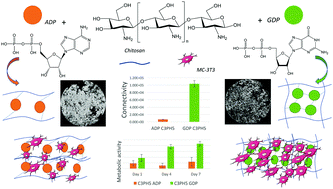当前位置:
X-MOL 学术
›
J. Mater. Chem. B
›
论文详情
Our official English website, www.x-mol.net, welcomes your
feedback! (Note: you will need to create a separate account there.)
The bioconjugation mechanism of purine cross-linkers affects microstructure and cell response to ultra rapidly gelling purine–chitosan sponges†
Journal of Materials Chemistry B ( IF 6.1 ) Pub Date : 2017-12-20 00:00:00 , DOI: 10.1039/c7tb02968c Laila Benameur 1, 2, 3, 4 , Timothée Baudequin 1, 2, 3, 4 , Mina Mekhail 1, 2, 3, 4 , Maryam Tabrizian 1, 2, 3, 4, 5
Journal of Materials Chemistry B ( IF 6.1 ) Pub Date : 2017-12-20 00:00:00 , DOI: 10.1039/c7tb02968c Laila Benameur 1, 2, 3, 4 , Timothée Baudequin 1, 2, 3, 4 , Mina Mekhail 1, 2, 3, 4 , Maryam Tabrizian 1, 2, 3, 4, 5
Affiliation

|
As a cell carrier, cross-linking is one of the most common approaches used to provide chitosan with greater structural integrity. We introduced a cross-linking strategy by using two purines, guanosine 5′-diphosphate (GDP) or adenosine 5′-diphosphate (ADP), as cross-linkers. The rationale for this approach is that both GDP and ADP have an important physiological role and act as intercellular signaling molecules in numerous biological processes. The slight difference between the chemical structure of guanine and adenosine in GDP and ADP, respectively, affect the cross-linking mechanism. This resulted in a different scaffold microstructure and thus, altered the response of encapsulated cells to the scaffold. FTIR and solid-state 13C-NMR revealed the formation of a quadruplex structure among the four GDP molecules confined between the chitosan backbone. This resulted from the ability of guanine to form intermolecular hydrogen bonds, while adenosine in ADP lacks this capacity. The formation of a more organized structure in GDP-chitosan sponges also increased the crystallinity of the sponge as shown by X-ray diffraction data. Further, physicochemical analyses with SEM and μCT indicated a more open-pore architecture and increased porosity. Although an active population of encapsulated cells was maintained in all chitosan sponges overtime, the GDP-based sponges provided a 6-fold increase in the activity of MC-3T3 cells and significantly enhanced their proliferation due to a more appropriate microstructure. Overall, these findings suggest that slight changes in the chemical structure of the cross-linker in the preparation of chitosan-based biomaterials will have a significant impact on the structural properties of the chitosan. This important parameter can be utilized to modulate cell response and to understand the cell signaling pathway of chitosan-based biomaterials in the context of their applications in tissue engineering.
中文翻译:

嘌呤交联剂的生物共轭机制影响超快胶化嘌呤-壳聚糖海绵的微观结构和细胞反应†
作为细胞载体,交联是用于为壳聚糖提供更大结构完整性的最常用方法之一。我们通过使用两个嘌呤鸟嘌呤5'-二磷酸(GDP)或腺苷5'-二磷酸(ADP)作为交联剂引入了交联策略。这种方法的基本原理是GDP和ADP都具有重要的生理作用,并在许多生物过程中充当细胞间信号分子。鸟嘌呤和腺苷的化学结构在GDP和ADP中的细微差别分别影响交联机理。这导致了不同的支架微结构,因此改变了包封的细胞对支架的反应。FTIR和固态13C-NMR揭示了在壳聚糖骨架之间的四个GDP分子之间形成了四重结构。这是由于鸟嘌呤形成分子间氢键的能力所致,而ADP中的腺苷缺乏这种能力。X射线衍射数据显示,GDP-壳聚糖海绵中更有组织的结构的形成也提高了海绵的结晶度。此外,用SEM和μCT进行的理化分析表明,它具有更开孔的结构和更高的孔隙率。尽管所有壳聚糖海绵中都保留了活跃的封装细胞群,但是基于GDP的海绵使MC-3T3细胞的活性增加了6倍,并且由于更合适的微观结构而大大增强了它们的增殖。全面的,这些发现表明,在制备基于壳聚糖的生物材料中交联剂的化学结构的细微变化将对壳聚糖的结构性质产生重大影响。在壳聚糖基生物材料在组织工程中的应用背景下,该重要参数可用于调节细胞反应和了解细胞信号通路。
更新日期:2017-12-20
中文翻译:

嘌呤交联剂的生物共轭机制影响超快胶化嘌呤-壳聚糖海绵的微观结构和细胞反应†
作为细胞载体,交联是用于为壳聚糖提供更大结构完整性的最常用方法之一。我们通过使用两个嘌呤鸟嘌呤5'-二磷酸(GDP)或腺苷5'-二磷酸(ADP)作为交联剂引入了交联策略。这种方法的基本原理是GDP和ADP都具有重要的生理作用,并在许多生物过程中充当细胞间信号分子。鸟嘌呤和腺苷的化学结构在GDP和ADP中的细微差别分别影响交联机理。这导致了不同的支架微结构,因此改变了包封的细胞对支架的反应。FTIR和固态13C-NMR揭示了在壳聚糖骨架之间的四个GDP分子之间形成了四重结构。这是由于鸟嘌呤形成分子间氢键的能力所致,而ADP中的腺苷缺乏这种能力。X射线衍射数据显示,GDP-壳聚糖海绵中更有组织的结构的形成也提高了海绵的结晶度。此外,用SEM和μCT进行的理化分析表明,它具有更开孔的结构和更高的孔隙率。尽管所有壳聚糖海绵中都保留了活跃的封装细胞群,但是基于GDP的海绵使MC-3T3细胞的活性增加了6倍,并且由于更合适的微观结构而大大增强了它们的增殖。全面的,这些发现表明,在制备基于壳聚糖的生物材料中交联剂的化学结构的细微变化将对壳聚糖的结构性质产生重大影响。在壳聚糖基生物材料在组织工程中的应用背景下,该重要参数可用于调节细胞反应和了解细胞信号通路。









































 京公网安备 11010802027423号
京公网安备 11010802027423号